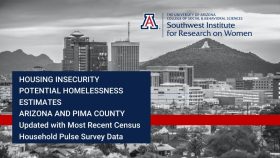
The University of Arizona Southwest Institute for Research on Women has released its most recent update to its report on Housing Insecurity Indicators and Potential Homelessness Estimates for Arizona and Pima County. This report measures current housing insecurity with newer census data.
This most recent survey wave contains multiple good signs:
- The positive macroeconomic situation has continued to hold steadily at both the national and state levels.
- The unemployment rate in Arizona, 3.6% in July, remains below historical averages.
- In the previous survey wave, collected June 28th-July 10th 2023, the proportion of non-current renters in Arizona was 9.3%. In the most recent survey, conducted July 26th- August 7th 2023, this proportion rose to 11.9%.
- While the proportion not current on rent payments increased, the proportion of these non-current renters viewing eviction in the next two months as “very likely” fell to 3.7%. This is down from 12% in the previous survey wave and one of the lowest proportions on this metric observed to date.
- The proportion viewing eviction as “somewhat likely” also fell to 30% of non-current renters, down from 55% in the previous survey wave.
- Mortgage holders in Arizona continue to be in a strong financial position relative to renters. Only 3.5% reported being not current on mortgage payments (down modestly from 5.4% in the previous survey). Among these non-current mortgage holders concern about the likelihood of foreclosure in the next two months is near the lowest levels observed in these surveys to date.
- Further good news is that since, roughly, February of 2023, counts of calls to 211 from Pima County indicate a substantial decrease in calls related to housing and shelter, utilities, and food requests in the last 5 months. That said, most of these metrics registered small increases relative to these declines in August.
- There is unambiguous good news in the rental vacancy rate, which has been trending upwards since the end of 2021, and hit an 8-year high in the 2nd quarter of 2023. 60% of all Arizona respondents reported they had not experienced pressure to move in the last 6 months.
While these improvements are welcome news, housing insecurity among Arizona renters remains stubbornly high despite historically low unemployment (and contrasts with the comparatively strong financial position of Arizona mortgage holders).
- Rising rents and inflation are likely the central drivers of this disconnect, especially for households with limitations on their ability to benefit from the strong labor market. Lower-income and BIPOC Arizona households remain disproportionately likely to report being not current on their rent payments and finding it very difficult to meet usual expenses.
- There is disappointing news to report on rents. In the fall of 2022 Tucson rent prices began decreasing on average, albeit very modestly. In the last few months all three summary metrics of rent prices in Tucson have registered upticks in median/average rent prices. This is terrible news, but we need to wait to see if this is a trend or a just modest variation over time.
- 8% of Arizona households reported reducing or not paying expenses for basic household necessities (such as medicine or food) “almost every month” in the last 12 months in order to pay an energy bill. Only 53% of households reported “never” being in this situation.
- Monthly counts of the number of people entering the Homeless Management Information System (HMIS) in Maricopa County indicate a continuing increase in the number of people experiencing homelessness in recent months.
- Nationwide, individuals reporting that they have serious disabilities continue to be disproportionately likely to report being behind on rent payments.
